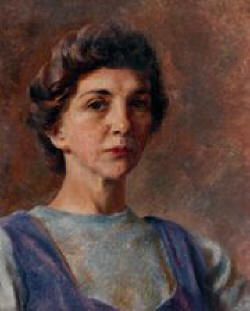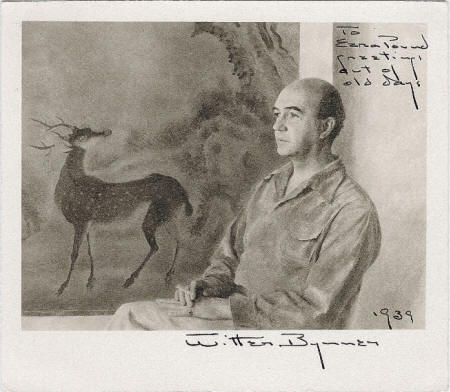

Queer Places:
Hurd La Rinconada Gallery & Guest Homes, 105 la Rinconada, San Patricio, NM 88348
 Henriette Wyeth Hurd (October 22, 1907 – April 3, 1997) was an American artist noted for her portraits and still life paintings. The eldest daughter of illustrator N.C. Wyeth, she studied painting with her father and brother Andrew Wyeth at their home and studio in Chadds Ford, Pennsylvania.
After she and artist Peter Hurd married, they moved to San Patricio, New Mexico, in the mid-1930s and raised their three children on a ranch there. They were both inspired by the landscape and eventually had a 2200-acre ranch.
She took a portrait of Witter Bynner
which is now in a museum in Roswell, New Mexico, and one of Robert Hunt, which
hung in Bynner's study in Santa Fe and is now lost.
Henriette Wyeth Hurd (October 22, 1907 – April 3, 1997) was an American artist noted for her portraits and still life paintings. The eldest daughter of illustrator N.C. Wyeth, she studied painting with her father and brother Andrew Wyeth at their home and studio in Chadds Ford, Pennsylvania.
After she and artist Peter Hurd married, they moved to San Patricio, New Mexico, in the mid-1930s and raised their three children on a ranch there. They were both inspired by the landscape and eventually had a 2200-acre ranch.
She took a portrait of Witter Bynner
which is now in a museum in Roswell, New Mexico, and one of Robert Hunt, which
hung in Bynner's study in Santa Fe and is now lost.
Henriette Wyeth was born in Wilmington, Delaware, into an artistic family. Wyeth was the eldest of the five children of noted illustrator N.C. Wyeth and his wife Carolyn Bockius.[2] Her siblings Carolyn and Andrew also became artists, and all three studied with their father. Andrew Wyeth became the most well-known artist of this family.[3] Henriette contracted polio at age 3, which altered her health and use of her right hand. As a result, she learned to draw with her left hand and paint with her right.[4] She grew up on the family farm in Chadds Ford, Pennsylvania, and attended local Quaker schools.[5] She and her siblings were eventually homeschooled because their father distrusted the public school system. She began formal art lessons with her father at age 11, making charcoal studies and geometric shapes. A child prodigy,[6] at age 13 Wyeth was enrolled in the Normal Arts School in Boston, Massachusetts. The next year, in 1921, she entered the Boston Museum of Art Academy. Two years later she moved to Philadelphia to study painting at the Pennsylvania Academy of Fine Arts.[2] By age 16, she was well known as a portraitist and received commissions for paintings of Wilmington residents. Deeply influenced by her father's unique realistic style, she rejected early 20th-century painting styles such as Impressionism and Cubism. She was also socially and politically conservative. As a result, later in life she rejected the progressive movements of the 1960s and 1970s, including the women's movement. She often criticized television and modern culture.[6]

Title
Bynner, Witter,
Creator
Wyeth, Henriette
At age 21, in 1929 Wyeth married artist Peter Hurd, a fellow student at the Pennsylvania Academy and her father's apprentice. The couple had three children together: Peter Jr., Carolyn, and Michael Hurd. In the mid-1930s they moved to San Patricio, New Mexico, settling on a farm of 40 acres. By 1939, they established the Sentinel Ranch there, gradually acquiring more land until they had 2200 acres. It was in southern New Mexico near Roswell, New Mexico, her husband's birthplace.[5] Wyeth's father was not happy when they left the Pennsylvania area. As she said in a 1989 interview, “He felt I should not let marriage interfere with my painting” and worried that living on a ranch would draw her energy from it. Henriette Wyeth, however, did continue to paint for the rest of her life and was inspired by the landscape. Later health problems prevented her from making art.[6] Wyeth's work spanned portraits of adults and children, still lifes, and floral landscapes. In her work, she "often included objects that related to the subject's interest or personality..."[7] She eventually stopped painting children because, as she said, “today's children--they are so deadpan."[6] She criticized contemporary television and feminism, and said that modern society had “blunted” children. She painted for Helen Hayes, Paulette Goddard, and Mrs. John D. Rockefeller III (Blanchette Hooker Rockefeller), for which she earned a lasting celebrity.[6] In 1963, she painted a portrait of her brother Andrew for the cover of TIME Magazine. Hurd and Wyeth were both commissioned to produce a cover portrait of President Lyndon B. Johnson for Time's "Man of the Year" issue. Her most widely known work is the official White House portrait of First Lady Pat Nixon.[8] Henriette Wyeth died in her Roswell, New Mexico home-studio from complications from pneumonia in April 1997.[6] According to her biography on the Wyeth Hurd Gallery website, she was “considered by many art scholars to be one of the great women painters of the 20th century.”[9] Henriette Wyeth was buried on a hilltop on her Sentinel Ranch with about 150 friends and relatives in attendance. Peter Hurd is buried on the same hilltop overlooking the Ruidoso Valley.
Soon after her student years, Hurd exhibited at the Pennsylvania Academy (1927, 1936–44), where she was awarded the 1937 Mary Smith Prize for a portrait of her son Peter.[10] She received other awards for her work, including the Governor's Award in New Mexico[2] and a Living Legacy Award from the Women's International Center.[11] Much of her work is held by The Roswell Museum and Art Center, in Roswell[8] and at the Hurd La Rinconada Gallery in San Patricio, both in New Mexico. Her paintings can also be found in the permanent collections of the Brandywine River Museum in Pennsylvania, the Los Angeles Athletic Club, the National Portrait Gallery, the New Mexico Museum of Art in Santa Fe, and the Texas Tech University Fine Art Museum.[12] Her papers, and those of her husband (who died in 1984), are in the Archives of American Art at the Smithsonian Institution. One of her well-known quotes is: "I don't know what is important and what is unimportant, so I call it all immensely important."[11]
My published books: